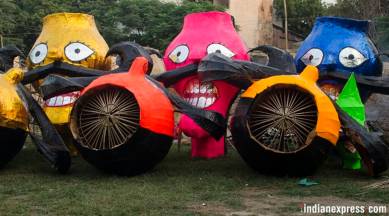Stay updated with the latest - Click here to follow us on Instagram
Come Dussehra and the Ravana makers of Titarpur know who is king
Once the festive season is over, the artisans will return to their professions such as carpenter, electricians and even painters, only to come back next year for the love of their craft.

The narrow stretch between West Delhi’s Tagore Garden and Subhash Nagar area is a locality known as Titarpur where Ravan, a symbol of evil and the principal villain of the epic Ramayana, takes birth every year. Here he is the King and much in demand — but only to be burnt on the occasion of Dussehra.
The Titarpur locality is famous for its effigies and the market is considered the largest market of the kind in Asia serving customers not only in Delhi but Rajasthan, Uttar Pradesh, Punjab and even abroad at times. The narrow stretch is where the trio of Ravana and his brothers Kumbhkaran and Meghnad effigies were made till last year when capital’s civic authorities objected. The artisans were termed as ‘encroachers’ and the effigies as the prime reason for traffic jams in the area.
monthly limit of free stories.
with an Express account.
After a year-long battle with the authorities and Delhi High Court’s intervention, the South Delhi Municipal Corporation (SDMC) identified two temporary sites — ‘Beri Wala Bagh’ and ‘Chhatriwala Park’ in Subhash Nagar for artisans to make Ravana effigies ahead of the festive season at the charge of Rs 1.50 per square feet per month. The artisans have also been provided with sanitation and housing facilities, including water and electricity.
Read | Will artisans make Ravana effigies after Dusshera, Delhi HC asks authorities
With Dussehra on Friday, the craftsmen are busy giving final touches to the effigies. Explaining the process of building an effigy, Teekaram, who hails from Moradabad and has an expertise of over 20 years in the craft, said the height of a Ravan effigy varies from 10 to 70 feet, depending upon the client’s demand. The framework is built with bamboo sticks which are bound using steel wire. This is followed by wrapping the frame with old sarees and later with khaki paper.
“The framework is then laden with a layered cloth and brown paper, followed by the pasting of coloured paper using glue, which is then painted and decorated once it dries,” he adds.
Read | Delhi HC to SDMC: Ensure area allotted to effigy makers is available without hindrance
Another artisan, Danveer Karan, a farmer like many others, arrived at Delhi just after Raksha Bandhan to work as an effigy maker. He told indianexpress.com that on an average it takes about six to eight days to complete an effigy.
However, with skyrocketing prices of petrol, raw materials and dwindling demand of effigies, the business is less profitable now, claims Satpal Rai, who has been involved in the trade for over 30 years.
“I make effigies ranging from 1 feet to 50 feet, this season I am making 51 effigies and have over 20 workers working on them. On an average, an effigy costs around Rs 12,000 to us and is sold for around Rs 16,000, but with inflation and an increase in fuel prices, the profit margin has lessened,” he added.
The demand for tall effigies is diminishing, but the craftsmen have noticed a dramatic change in the customers buying these effigies. Not many know that most of the buyers of these effigies are individuals and not Ramleela committees. The clientele also includes Residential Welfare Associations (RWAs) and societies who demand relatively small effigies for community celebrations.
Once the festive season is over, the artisans will return to their professions such as carpenter, electricians and even painters, only to come back next year for the love of their craft. For the past few years, there have been several hiccups but the artisans are hopeful as Ravana is not the demon king for them but a source of their livelihood.